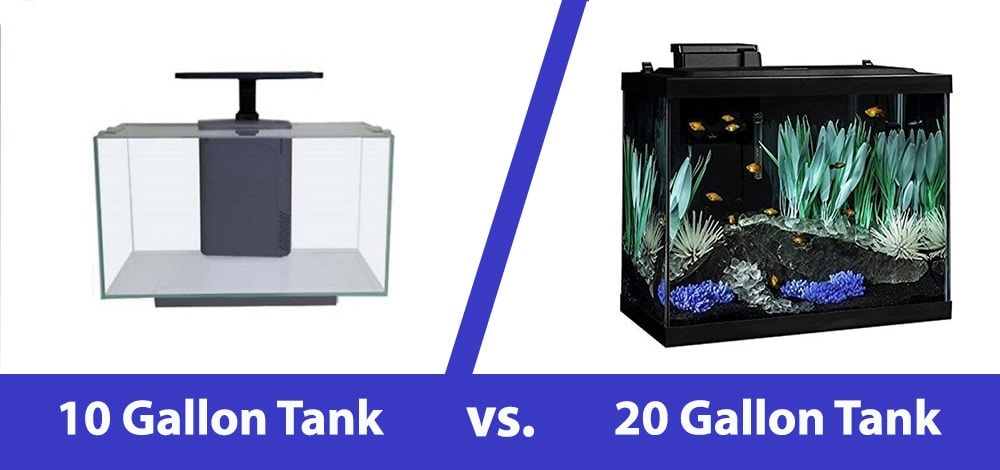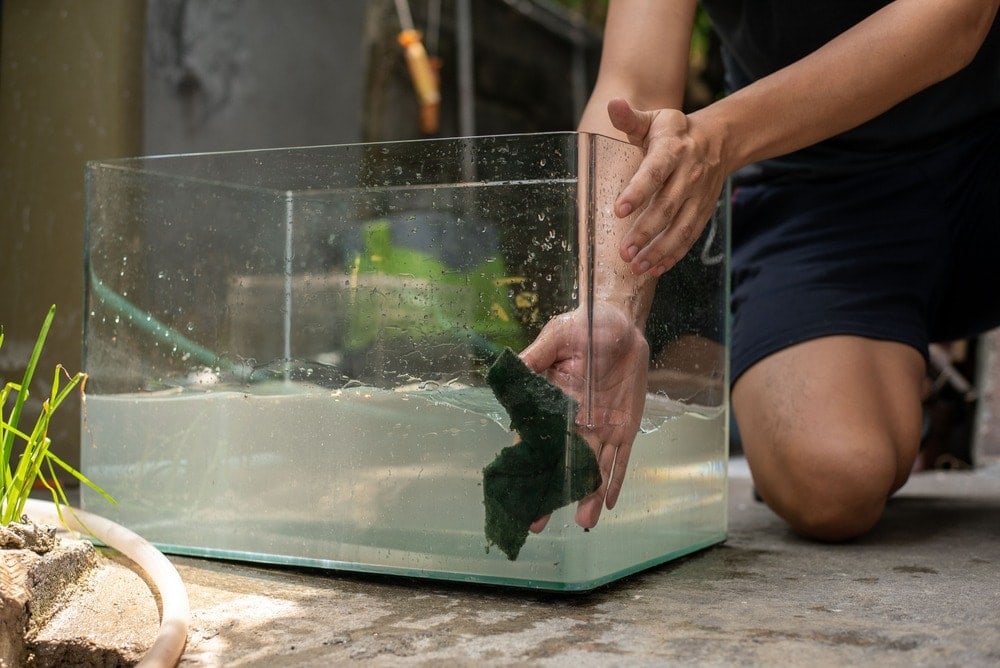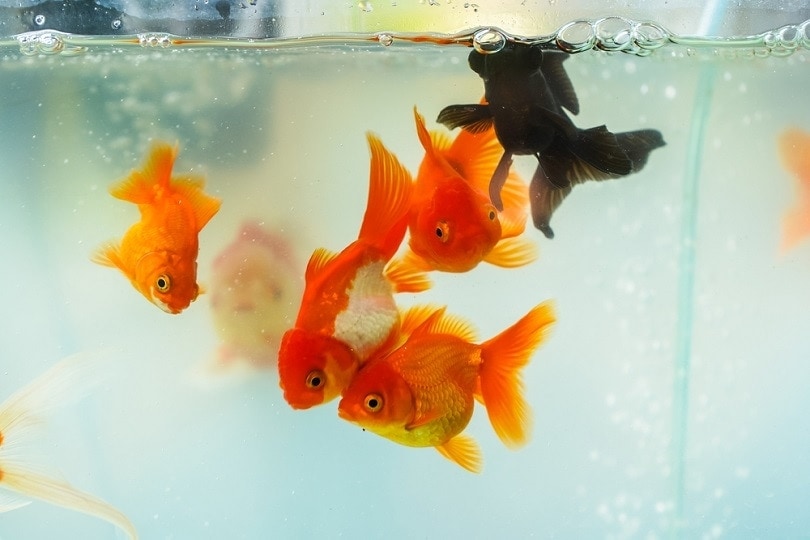Bristlenose Pleco: Care Guide, Size, Varieties & Lifespan

Updated on
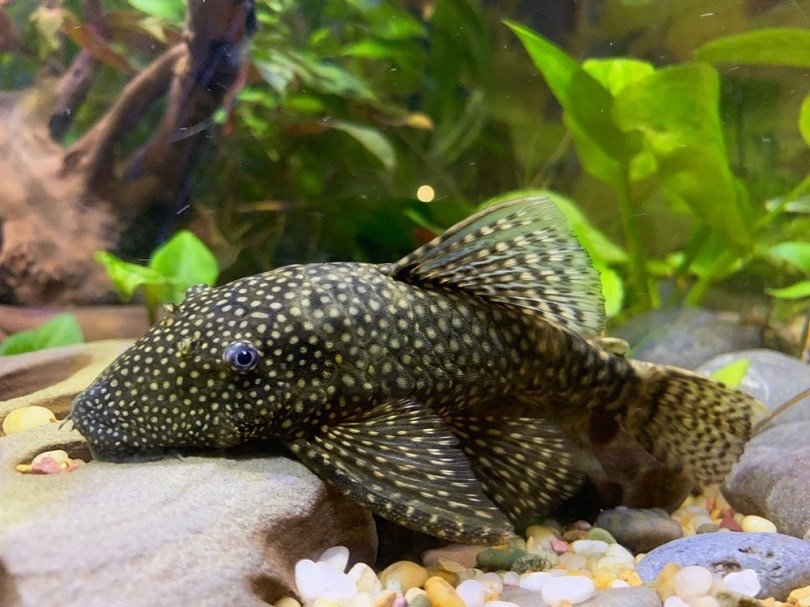
The Plecostomus is an aquarium staple, often seen sticking to the sides of tanks or hiding in caves and tunnels. What many people don’t realize is that there are multiple varieties of Plecos available in the aquatics market. They also don’t realize is that the Common Plecostomus gets really big. Like, around 2 feet long and needing its own tank kind of big.
The good news for Pleco lovers is there are varieties available that stay much smaller and more manageable. One of the most unique of these varieties is the Bristlenose Pleco.
Quick Facts about Bristlenose Pleco
| Species Name: | Ancistrus Cirrhosus |
| Family: | Loricariidae |
| Care Level: | Easy |
| Temperature: | 73-82°F |
| Temperament: | Peaceful |
| Color Form: | Brown, tan, green, lemon, orange, albino |
| Lifespan: | 5-15 years |
| Size: | 3-6 inches |
| Diet: | Mainly herbivorous |
| Minimum Tank Size: | 20 gallons |
| Tank Set-Up: | Freshwater with tannins, driftwood, and caves |
| Compatibility: | Other peaceful tropical fish |
Bristlenose Pleco Overview

The Bristlenose Pleco is usually a pretty typical-looking pleco when you spot them in pet stores. However, around 3 inches or so, they develop whisker-like bristles on their face and snout, making them very distinct from other plecos. They make a great alternative to Common Plecos and other large varieties.
These fish are peaceful, but they are tropical fish and tend to end up purchased for their novelty or perceived algae cleaning abilities. When purchased for these reasons, they often end up in inappropriate tank environments, significantly shortening their life expectancy. There have also been some anecdotal reports of different types of plecos sucking the slime coat off of goldfish, injuring the goldfish.
Bristlenose Plecos are nocturnal, so the recommendation is to feed the tank at lights out time to make sure they get enough to eat. Some people make the mistake of thinking they will survive off the algae in the tank, but this is not true. They do need to be fed and since an aquarium is a closed system, no new nutrients are added to the tank unless they’re intentionally added.
How Much Do Bristlenose Pleco Cost?
These fish can range from very budget-friendly to costly depending on the color morph you purchase. Wild type and albinos can usually be purchased for about $5-$20. Special color morphs, like blue-eyed lemon and green dragons, can range all the way up to almost $100. Specialty types are usually special ordered, which will likely involve a shipping fee of around $35 as well, so you can easily spend over $100 on a specialty Bristlenose Pleco.
Typical Behavior & Temperament
Bristlenose Plecos are docile fish and are more apt to be out during the day than some other nocturnal fish. They do like to have quiet hideouts for daytime hours, though. Female Bristlenose Plecos stay docile their entire lives, even during spawning. However, males, especially juveniles, may become aggressive during this time. They will fight other Bristlenose Pleco males, sometimes to the death, and may attack other fish during this time.

Appearance & Varieties
Bristlenose Plecos are part of the armored catfish family, so they have sturdy, armored scales across their body. They do have some softer spots on their bellies, but these scales keep them well-protected from predation. They usually have short fins, but there are long fin varieties.
Bristlenose Plecos in the wild are usually found in “wild type” colors, which are often browns and tans, to help them blend into their environment. Albino can naturally occur in the wild, but this can shorten the life expectancy of the fish since it increases their risk of being spotted by predators. However, as Bristlenose Plecos have been selectively bred in captivity, other color morphs have emerged. The following are some of the color varieties you might find Bristlenose Plecos in.
- Wild Type: Usually browns and tans, these fish may also have black or other natural colors on them. They are usually patterned in a camouflage manner that helps them blend into their environment.
- Albino: These fish are born with little to no color making them appear white or yellow, although they are sometimes seen with brown markings. Their eyes are pink or red.
- Blue-Eyed Lemon: These are sometimes confused with albino. They come in many shades of yellow but are usually seen in bright lemon yellow. Blue eyes are a distinguishing characteristic of this variety.
- Green Dragon: These fish come in a variety of green shades and may be solid or patterned. Their patterns can feature white, brown, tan, or yellow, but are often green.
- Starlight: These fish can be many base colors, but they are covered in white flecks across their bodies that make them look like they are covered in stars.
- Super Red: These fish actually tend to be more of an orange shade, but their color is distinctive from the other color morphs. This is a highly sought after variety of Bristlenose Pleco and can be very expensive.
How to Take Care of Bristlenose Pleco
Tank/Aquarium Size
The minimum tank size for Bristlenose Plecos is 20 gallons, but 30 gallons or larger is recommended. They create a lot of waste, and if kept in smaller tanks, more frequent tank maintenance is required.
Water Temperature & pH
Bristlenose Plecos are tropical fish, so they prefer water temperatures from 73-82°F. They can survive in water as cool as 60°F but this can stress them and shorten their lifespan. They prefer a pH of 6.5-7.5, so a neutral tank is ideal, but they can survive in slightly acidic water as well.
Substrate
Most substrates are acceptable for Bristlenose Plecos. In nature, they live in bodies of water with mud, clay, and/or gravel, so these options will most closely represent their natural habitat. However, they will happily live with any substrate.
Plants
Plants that can live in neutral, tropical water are great for Bristlenose Plecos. Since these fish are nocturnal, providing lots of plant cover will not only give them shelter, but it will also decrease the amount of light that reaches the bottom of the tank, creating a more natural environment for your Bristlenose Pleco.
Lighting
Since their eyes can be sensitive to bright lights, low to moderate lighting is best unless you are able to provide plenty of hiding places and plant cover. Anubias, Amazon swords, Java ferns, hornwort, and dwarf water lettuce are all great options for your Bristlenose Pleco’s tank.
Filtration
In nature, Bristlenose Plecos are used to fast-moving water, so they will appreciate a current in your tank. The most important part of a Bristlenose Pleco’s tank is providing excellent filtration because these fish produce a large amount of waste.
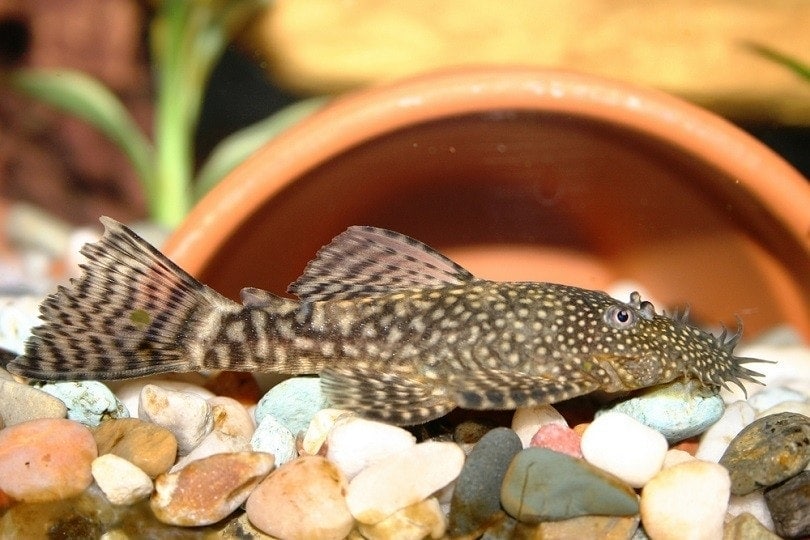
Are Bristlenose Pleco Good Tank Mates?
Introducing a new Bristlenose Pleco to your community tank shouldn’t be an issue, although it’s good practice to quarantine them prior to introducing them to monitor for any illnesses they may have picked up in the fish store. They may settle right in, but it’s more likely they will hide for the first few days, slowly making more appearances until they feel safe and comfortable with the new environment.
Their docile, gentle nature makes them good tank mates, but the amount of waste they produce should be accounted for when choosing filtration for your community tank. It’s best to provide filtration that is labeled for a tank size above the size of your tank to ensure filtration is adequate.
Bristlenose Plecos can be housed with other docile tropical fish that have the same water parameter needs. They shouldn’t be housed with goldfish and other cool or cold water fish. It’s a good idea to avoid pairing them with fish that may nip at this as this could cause undue stress, although it’s unlikely to injure them because of their armored scales.
What to Feed Your Bristlenose Pleco
Bristlenose Plecos will happily snack on algae and potentially some plants in your tank, but they should also be offered food. They are largely herbivorous and will gladly accept algae wafers and just about anything containing plant matter. They love fresh foods, like romaine lettuce, arugula, cilantro, parsley, broccoli, cantaloupe, and many other fruits and veggies. Sinking foods are ideal and the use of weights for floating foods is a good idea so they don’t have to search far for food.
On occasion, you can offer your Bristlenose Pleco frozen thawed treats, like brine shrimp and bloodworms, and sinking omnivore foods. They are extremely unlikely to go after live food but will often snack on a meaty treat when it’s offered to them. These foods are high in protein and rich for Bristlenose Plecos, so feed them in moderation to prevent constipation and swim bladder problems.
Keeping Your Bristlenose Pleco Healthy
A healthy tank environment is the best way to keep your Bristlenose Pleco happy and healthy. Don’t make the mistake of not feeding it, though. While they do eat algae, they should not be relied upon to completely clear a tank of algae and they need a more varied diet than just tank algae.
Make sure you’re providing a varied diet with different plant sources, including fresh, frozen, and pre-made foods. This will ensure your Bristlenose Pleco is getting all the nutrients it needs to stay healthy. Some people recommend feeding a few small pieces of cooked, shelled pea every week to proactively prevent constipation and swim bladder dysfunction.
Breeding
In a healthy, safe tank environment, Bristlenose Plecos may breed, but lowering the tank temperature slightly may encourage spawning. While you can keep multiple females together, it’s best not to keep multiple males together since they may become extremely aggressive during spawning.
During spawning, females will go into a male’s cave and deposit the eggs there, and then the male will fertilize the eggs. After the eggs are fertilized, the male will kick the female out. Male Bristlenose Plecos are the singular caregivers to the eggs until the fry hatch.
Once the eggs are fertilized, the eggs will take 2-10 days to hatch. The entire time, the male will care for the eggs. After hatching, the fry will attach themselves to a surface and stay there for 2-4 more days before they start moving around the tank and feeding. In a community tank, there is a good chance the fry will get eaten, so if you want successful breeding, the eggs, fry, or breeding Bristlenose Plecos should be moved to a different tank or breeder box.
Are Bristlenose Pleco Suitable For Your Aquarium?
Bristlenose Plecos are easy to care for and make great fish for beginner aquarists. They are a commitment of multiple years and should be provided with an appropriate tank environment. This includes keeping the pH and temperature in their preferred range. Otherwise, you risk shortening their lifespan.
If you’re interested in a planted tank with lots of caves and hiding places, then a Bristlenose Pleco would make a great addition to your tank. They should not be kept with aggressive fish or in tanks without adequate places to hide. These tropical fish are interesting and can be fun to watch, but don’t expect to see them throughout the day like diurnal, or out during the day, fish.
Check out some of our favorite posts:
Featured Image Credit: TTONN, Shutterstock



